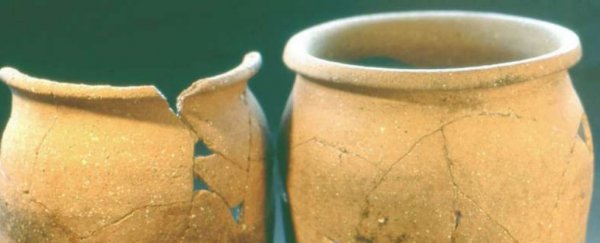Thirty years ago, archaeologists digging at one of England's earliest medieval villages discovered the remains of 73 worn cooking pots.
Used for the last time half a millennium ago, they still hold tiny remnants of their final meal. Which means they provide fascinating insight into what medieval people actually ate on a day-to-day basis.
Chemically extracting food residues from the pottery - a modern technique called organic residue analysis - researchers from the University of Bristol have found that many of these clay pieces contain elements of fat, and that's especially true for the fragments belonging to jars.
"This confirms pottery would likely have played an important role in medieval cooking, allowing the slow cooking of the stews and pottages, suggested by documentary evidence to be the mainstay of the medieval peasant diet," the authors write.
Apart from a few historical documents and accounts, the discovery represents the first direct evidence of a peasant medieval menu in England. And even though royal diets are quite well documented, up until now, historians weren't exactly sure what the lower classes ate.
Now, it seems that the mainstay of the medieval diet were stews and pottages, boiling with beef, mutton, cabbage, leak and other leafy vegetables. None of these are particularly surprising to historians, but the village of West Cotton in Northamptonshire did appear to eat surprisingly little fish.
"The association between cabbage and stewed meat is particularly noteworthy as there are few references in other sources for peasant culinary practice and a stew of this type was not to be found in high status kitchens," the authors write.
"Some evidence of porcine product processing was found, but, interestingly, it seems that fish did not feature significantly in the medieval peasant diet."
Traces of dairy products were also a crowd favourite. In fact, the authors claim that roughly a quarter of all these vessels were used solely for dairy - most probably for a 'green cheese' commonly eaten at the time.
Comparing these results with medieval animal remains also found at the site, the team was able to write up a sort of peasant cookbook, one that not only describes what they ate, but also how they butchered it, prepared it and got rid of the scraps.
"All too often in history the detail, for example food and clothing, of the everyday life of ordinary people is unknown," says lead researcher Julie Dunne, a geochemist from the University of Bristol.
"Traditionally, we focus on the important historical figures as these are the people discussed in ancient documents. Much is known of the medieval dietary practices of the nobility and ecclesiastical institutions, but less about what foods the medieval peasantry consumed."
This study has been published in the Journal of Archaeological Science.
